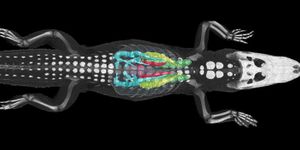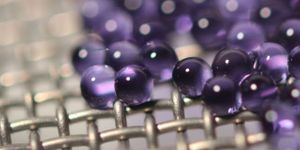A robust new material is extraordinarily adept at destroying toxic nerve agents that were first used 100 years ago during World War I and continue to be a global threat and a challenge to combat.
It only takes minutes for the material, a zirconium-based metal-organic framework (MOF), to degrade one of the most toxic chemical agents known to humankind: Soman (GD), a more toxic relative of sarin.
Computer simulations show the MOF should also be effective against other easy-to-make agents, such as VX.

The catalyst is fast and effective under a wide range of conditions, and the porous MOF structure can store a large amount of toxic gas as the catalyst does its work-features make the material promising for use in protective equipment worn by soldiers, such as gas masks, and for destroying stockpiles of chemical weapons, such as those currently building up in Syria.
"This designed material is very thermally and chemically robust, and it doesn't care what conditions it is in," says chemist Omar K. Farha, a research professor of chemistry at Northwestern University who led the research.
"The material can be in water or a very humid environment, at a temperature of 130 degrees or minus 15, or in a dust storm. A soldier should not need to worry about under what conditions his protective mask will work. We can put this new catalyst in rugged conditions, and it will work just fine."
MOFs are very porous, so they can capture, store and destroy a lot of the nasty material, Farha says, making them very attractive for defense-related applications.
Renders toxic agent harmless
Published in Nature Materials, the study is the first to demonstrate zirconium MOFs as effective weapons against nerve agents.
"Simple changes to the nerve agent's molecular structure can change something that can kill a human into something harmless," Farha says. "GD and VX are not very sophisticated agents, but they are very toxic. With the correct chemistry, we can render toxic materials nontoxic."
Metal-organic frameworks are well-ordered, lattice-like crystals. The nodes of the lattices are metals, and organic molecules connect the nodes. Within their very roomy pores, MOFs can effectively capture gases, such as nerve agents.
The new metal-organic framework, called NU-1000, has nodes of zirconium-the active catalytic site where all the important chemistry takes place. The organic ligand gives the material its important structure by connecting the nodes, but it does not participate in the catalysis of the nerve agent.
The zirconium node selectively clips the phosphate-ester bond in the nerve agent, rendering it innocuous. With the critical bond broken, the rest of the molecule is left alone. The bond is broken through the process of hydrolysis, a reaction involving the breaking of a molecule's bond using water. The MOF can use the humidity in the air.
Inspired by bacteria
Researchers first tested their catalyst against a GD simulant, called DMNP, and found the MOF degraded half of the target in less than 1.5 minutes. Next, they tested the MOF against GD and found the catalyst degraded half of the nerve agent in less than three minutes. These half-lives are very impressive, Farha says, and show how well the catalyst is working.
They also tested the zirconium cluster alone, without the cluster being in the MOF structure, and the catalyst was not as effective at degrading the nerve agent. This shows the importance of the MOF scaffold.
The research team's experimental and computational results suggest that the extraordinary activity of NU-1000 comes from the unique zirconium node and the MOF structure that allows the material to engage with more of the nerve agent and to destroy it. The researchers expect the MOF to be effective against other easy-to-make chemical warfare agents with phosphate-ester bonds, such as VX.
NU-1000 is inspired by the enzyme phosphotriesterase, which is found in bacteria. The natural enzyme has two zinc ions bridged by a hydroxyl group as the active catalytic site. Farha and his colleagues wanted to make a much more potent and stable catalyst, so they used zirconium ions instead of zinc.
Source: Futurity.org









